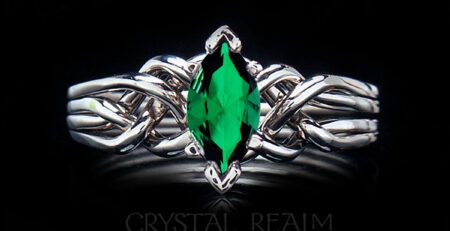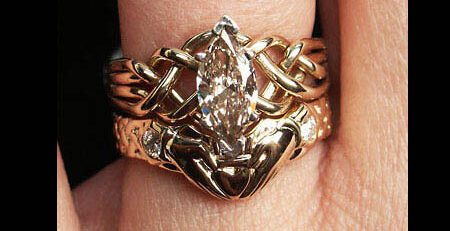Celtic Engagement Puzzle Ring with Trinity Knot Shadow Band
At long last, we have taken over the design and creation of our own shadow bands. Tom is now designing our shadow bands, which gives us much greater capability to develop new designs and respond to your desire for an original bridal set. Here is an image of the first shadow band that Tom designed from start to finish – working with the ideas of our clients who wanted a very specific band with a very particular meaning.
This couple wanted exactly four trinity knots on her shadow band. The two on the outside represent the two of them. The two trinity knots in the center represent the two of them coming together as one in marriage.
The shadow band is paired with her engagement puzzle ring, simply stunning with a 0.80Ct center Tsavorite garnet and two 5-pt accent diamonds. The puzzle ring is made of palladium and 14K rose gold. The shadow band is made of palladium. Palladium is a platinum-family metal that is naturally white, and we use it instead of white gold in bridal sets that have a white shadow band and a white (or white combination) engagement puzzle ring. Why don’t we use white gold for our sets? That’s another story, and you can find it below the image of this beautiful puzzle ring bridal set.

Marquise tsavorite garnet and diamond engagement puzzle ring with trinity knots shadow band all in palladium and 14K rose gold.
14K White Gold – The Complicated Story
White gold is not naturally white. Gold is yellow.
24K gold is 100% yellow gold.
18K gold is 75% gold and 25% alloyed metals.
14K gold is 58.5% gold and 41.5% alloyed metals.
The alloys make the gold stronger, so the more alloys, the stronger the metal. However, when you want to make white gold, the alloyed metals have to not only make it stronger, but they have to make it whiter. They can’t make it bright white, though, because, after all, it’s still mostly yellow gold.
Each manufacturer has their own formula for the alloys. Therefore, each manufacturer’s white gold can have a slightly different “cast” (tinge) to it. Some white gold has a creamish (golden) cast; some white gold has more of a pinkish cast. The modern jewelry industry has decreed that all modern white gold will be plated with rhodium, another platinum-family metal that makes white gold rings, no matter their source, all a uniform bright white. This way they always match in color.
However, our 14K white gold puzzle rings are not plated with rhodium. They have a slightly creamish cast to them. There are three reasons why we don’t plate our puzzle rings.
1. They are inspired by Celtic and Renaissance styles, and rings were not plated until the modern era.
2. We often do color combinations in our puzzle rings, and we can’t plate two bands while not plating the others.
3. Rhodium plating wears off, and most local jewelers have a bread-and-butter business of replating white gold rings 1-3 times per year. We don’t want to enslave you to having your rings replated over and over again. It’s expensive.
Our 14K white gold puzzle rings actually happen to match our 14K white gold traditional and contemporary posy rings, which are not plated and which also have a slightly creamish tinge to them. But our shadow bands, even if we make them without rhodium, may not match our 14K white gold puzzle rings. As an example, one might be slightly yellowish, and one could be slightly pinkish.
We use platinum or palladium for our shadow bands and mate them to engagement puzzle rings made of the same metal. This way our white metals match. The metal of the engagement puzzle ring will match the metal of the shadow band.





Leave a Reply
You must be logged in to post a comment.